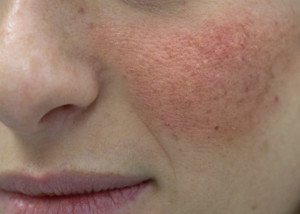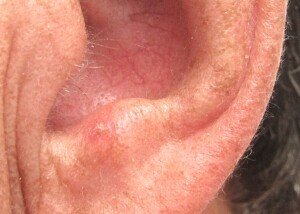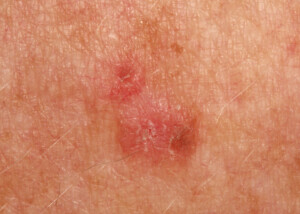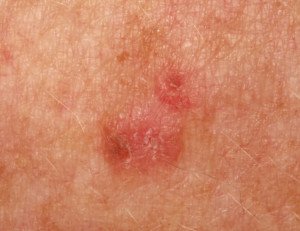
Actinic keratosis is a so-called precancerous lesion caused by sun damage.
Can these lesions be prevented with application of retin A?
Retin A is also known as retinoic acid.
To find out if retin A could have a preventive effect against actinic keratosis, I consulted with dermatologist Richard Bezozo, MD, President of MoleSafe, the world’s most advanced melanoma screening program.
Dr. Bezozo’s answer is: “No.”
Just what is actinic keratosis?
“AK is also known as solar keratosis,” says Dr. Bezozo.
“They are scaly crusty growths that develop slowly.
“Typically an eighth to one-fourth inch in size and caused by sun damage, AK indicates a risk for skin cancer.”
Actinic keratoses are extremely common in people over 40.
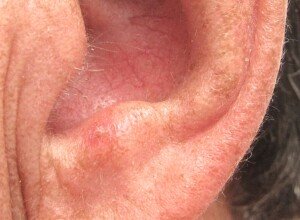
Actinic keratosis on the ear. Future FamDoc, CreativeCommons
Just what does “precancerous” mean for this condition?
Dr. Bezozo says, “Ten percent will advance to squamous cell cancer.”
However, you need to keep this information in the proper context:
The advancement occurs in 10 percent of untreated cases; and many times, a person fails to seek treatment — giving the lesion ample time to get worse.
Sometimes, the patient is unaware of the presence of a developing lesion (it may be, for instance, on their scalp).
Squamous cell carcinoma kills about 3,500 Americans a year and grows slowly, and many people just don’t realize something sinister has been slowly growing on their face, neck and other sun-exposed areas for a long time, and may shrug the lesions off as benign signs of aging skin.
Preventing Actinic Keratosis
Dr. Bezozo says: “Prevention techniques include using a broad spectrum UVA/UVB sun protection. By the time you get them the damage has been done. Retin A is typically used to treat acne.”
Though most patients are over 40, younger people are not immune to actinic keratoses.
Application of retin A may help manage other conditions, but this is not one of them.

Richard Bezozo, MD
There are more new cases yearly of skin cancer than breast, prostate, lung and colon cancers combined. The MoleSafe system produces high-resolution diagnostic images and creates a profile for your skin that’s monitored for any changes in moles.
 Lorra Garrick has been covering medical, fitness and cybersecurity topics for many years, having written thousands of articles for print magazines and websites, including as a ghostwriter. She’s also a former ACE-certified personal trainer.
Lorra Garrick has been covering medical, fitness and cybersecurity topics for many years, having written thousands of articles for print magazines and websites, including as a ghostwriter. She’s also a former ACE-certified personal trainer.
.

